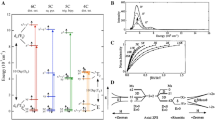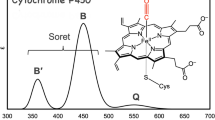Abstract
Biosynthesis of the tryptophan tryptophylquinone (TTQ) cofactor activates the enzyme methylamine dehydrogenase. The diheme enzyme MauG catalyzes O-atom insertion and cross-linking of two Trp residues to complete TTQ synthesis. Solution optical and Mössbauer spectroscopic studies have indicated that the reactive form of MauG during turnover is an unusual bisFe(IV) intermediate, which has been formulated as a His-ligated ferryl heme [Fe(IV)=O] (heme A), and an Fe(IV) heme with an atypical His/Tyr ligation (heme B). In this study, Fe K-edge X-ray absorption spectroscopy and extended X-ray absorption fine structure studies have been combined with density functional theory (DFT) and time-dependent DFT methods to solve the geometric and electronic structures of each heme site in the MauG bisFe(IV) redox state. The ferryl heme site (heme A) is compared with the well-characterized compound I intermediate of cytochrome c peroxidase. Heme B is unprecedented in biology, and is shown to have a six-coordinate, S = 1 environment, with a short (1.85-Å) Fe–O(Tyr) bond. Experimentally calibrated DFT calculations are used to reveal a strong covalent interaction between the Fe and the O(Tyr) ligand of heme B in the high-valence form. A large change in the Fe–O(Tyr) bond distance on going from Fe(II) (2.02 Å) to Fe(III) (1.89 Å) to Fe(IV) (1.85 Å) signifies increasing localization of spin density on the tyrosinate ligand upon sequential oxidation of heme B to Fe(IV). As such, O(Tyr) plays an active role in attaining and stabilizing the MauG bisFe(IV) redox state.












Similar content being viewed by others
Notes
A first shell with four Fe–N/O components has a slightly better F value, but the 4.5 Fe–N/O fit is more consistent with the crystal structure.
This short distance is consistent with Fe–O distances (1.83–1.94 Å) obtained from a small-molecule database on related species.
Resolution is the separation at which two different metal–ligand paths can be distinguished.
Abbreviations
- CCP:
-
Cytochrome c peroxidase
- CCP-I:
-
Compound I of cytochrome c peroxidase
- DFT:
-
Density functional theory
- EXAFS:
-
Extended X-ray absorption fine structure
- HOMO:
-
Highest occupied molecular orbital
- LUMO:
-
Lowest unoccupied molecular orbital
- MADH:
-
Methylamine dehydrogenase
- 4MP:
-
4-Methylphenolate
- TD-DFT:
-
Time-dependent density functional theory
- TTQ:
-
Tryptophan tryptophylquinone
- XAS:
-
X-ray absorption spectroscopy
References
Wang Y, Graichen ME, Liu A, Pearson AR, Wilmot CM, Davidson VL (2003) Biochemistry 42:7318–7325
McIntire WS, Wemmer DE, Chistoserdov A, Lidstrom ME (1991) Science 252:817–824
Davidson VL (2003) Biochim Biophys Acta 1647:230–233
Li X, Jones LH, Pearson AR, Wilmot CM, Davidson VL (2006) Biochemistry 45:13276–13283
Pearson AR, De La Mora-Rey T, Graichen ME, Wang Y, Jones LH, Marimanikkupam S, Agger SA, Grimsrud PA, Davidson VL, Wilmot CM (2004) Biochemistry 43:5494–5502
Wang Y, Li X, Jones LH, Pearson AR, Wilmot CM, Davidson VL (2005) J Am Chem Soc 127:8258–8259
Li X, Fu R, Lee S, Krebs C, Davidson VL, Liu A (2008) Proc Natl Acad Sci USA 105:8597–8600
Jensen LMR, Sanishvili R, Davidson VL, Wilmot CM (2010) Science 327:1392–1394
Abu Tarboush N, Jensen LMR, Feng ML, Tachikawa H, Wilmot CM, Davidson VL (2010) Biochemistry 49:9783–9791
Li X, Feng M, Wang Y, Tachikawa H, Davidson VL (2006) Biochemistry 45:821–828
Lee S, Shin S, Li X, Davidson V (2009) Biochemistry 48(11):2442–2447
Makris TM, von Koenig K, Schlichting I, Sligar SG (2006) J Inorg Biochem 100:507–518
Rittle J, Green MT (2010) Science 330:933–937
Poulos TL, Raag R (1992) FASEB J 6:674–679
Riggs-Gelasco PJ, Price JC, Guyer RB, Brehm JH, Barr EW, Bollinger JM, Krebs C (2004) J Am Chem Soc 126:8108–8109
Shu LJ, Nesheim JC, Kauffmann K, Munck E, Lipscomb JD, Que L (1997) Science 275:515–518
Stone KL, Behan RK, Green MT (2005) Proc Natl Acad Sci USA 102:16563–16565
Meharenna YT, Doukov T, Li H, Soltis SM, Poulos TL (2010) Biochemistry 49:2984–2986
Tenderholt A (2005) PySpline. http://pyspline.sourceforge.net/
George GN (2000) EDG_FIT
de Leon JM, Rehr JJ, Zabinsky SI, Albers RC (1991) Phys Rev B 44:4146–4156
Rehr JJ, Albers RC (2000) Rev Mod Phys 72:621–654
Rehr JJ, Deleon JM, Zabinsky SI, Albers RC (1991) J Am Chem Soc 113:5135–5140
Zabinsky SI, Rehr JJ, Ankudinov A, Albers RC, Eller MJ (1995) Phys Rev B 52:2995–3009
Neese F (2008) ORCA, version 2.6.35
Neese F, Olbrich G (2002) Chem Phys Lett 362:170–178
Becke AD (1988) Phys Rev A 38:3098–3100
Becke AD (1993) J Chem Phys 98:5648–5652
Perdew JP (1986) Phys Rev B 33:8822–8824
Sinnecker S, Slep LD, Bill E, Neese F (2005) Inorg Chem 44:2245–2254
Schafer A, Horn H, Ahlrichs R (1992) J Chem Phys 97:2571–2577
Schafer A, Huber C, Ahlrichs R (1994) J Chem Phys 100:5829–5835
George SD, Neese F (2010) Inorg Chem 49:1849–1853
George SD, Petrenko T, Neese F (2008) J Phys Chem A 112:12936–12943
Schaftenaar G, Noordik JH (2000) J Comput Aided Mol Des 14:123–134
Tenderholt A (2005) QMForge. http://qmforge.sourceforge.net/
Chandrasekaran P, Stieber SCE, Collins TJ, Que L, Neese F, DeBeer S (2011) Dalton Trans 40:11070–11079
Hahn JE, Scott RA, Hodgson KO, Doniach S, Desjardins SR, Solomon EI (1982) Chem Phys Lett 88:595–598
Shulman RG, Yafet Y, Eisenberger P, Blumberg WE (1976) Proc Natl Acad Sci USA 73:1384–1388
Westre TE, Kennepohl P, DeWitt JG, Hedman B, Hodgson KO, Solomon EI (1997) J Am Chem Soc 119:6297–6314
Randall CR, Shu LJ, Chiou YM, Hagen KS, Ito M, Kitajima N, Lachicotte RJ, Zang Y, Que L (1995) Inorg Chem 34:1036–1039
Roe AL, Schneider DJ, Mayer RJ, Pyrz JW, Widom J, Que L (1984) J Am Chem Soc 106:1676–1681
Anderson LA, Dawson JH (1990) Struct Bonding 74:1–40
Cho J, Jeon S, Wilson SA, Liu LV, Kang EA, Braymer JJ, Lim MH, Hedman B, Hodgson KO, Valentine JS, Solomon EI, Nam W (2011) Nature 478:502–505
Chance M, Powers L, Poulos T, Chance B (1986) Biochemistry 25:1266–1270
Goodin DB, Mcree DE (1993) Biochemistry 32:3313–3324
Houseman ALP, Doan PE, Goodin DB, Hoffman BM (1993) Biochemistry 32:4430–4443
Pfister TD, Gengenbach AJ, Syn S, Lu Y (2001) Biochemistry 40:14942–14951
Sivaraja M, Goodin DB, Smith M, Hoffman BM (1989) Science 245:738–740
England J, Martinho M, Farquhar ER, Frisch JR, Bominaar EL, Munck E, Que L (2009) Angew Chem Int Ed 48:3622–3626
Fujimori DG, Barr EW, Matthews ML, Koch GM, Yonce JR, Walsh CT, Bollinger JM, Krebs C, Riggs-Gelasco PJ (2007) J Am Chem Soc 129:13408–13409
Jackson TA, Rohde JU, Seo MS, Sastri CV, DeHont R, Stubna A, Ohta T, Kitagawa T, Munck E, Nam W, Que L (2008) J Am Chem Soc 130:12394–12407
Hersleth HP, Ryde U, Rydberg P, Gorbitz CH, Andersson KK (2006) J Inorg Biochem 100:460–476
Gumiero A, Metcalfe CL, Pearson AR, Raven EL, Moody PC (2011) J Biol Chem 286:1260–1268
Ling Y, Davidson VL, Zhang Y (2010) J Phys Chem Lett 1:2936–2939
Acknowledgments
Portions of this research were performed at the Stanford Synchrotron Radiation Lightsource (SSRL), a Directorate of SLAC National Accelerator Laboratory and an Office of Science User Facility operated for the US Department of Energy Office of Science by Stanford University. The SSRL Structural Molecular Biology Program is supported by the Department of Energy Office of Biological and Environmental Research, and by the National Institutes of Health, the National Institute of General Medical Sciences (including P41GM103393), and the National Center for Research Resources (P41RR001209). C.M.W., V.L.D., and T.L.P were supported by the National Institutes of Health grants GM66569, GM41574, and GM42614, respectively.
Author information
Authors and Affiliations
Corresponding authors
Electronic supplementary material
Below is the link to the electronic supplementary material.
Rights and permissions
About this article
Cite this article
Jensen, L.M.R., Meharenna, Y.T., Davidson, V.L. et al. Geometric and electronic structures of the His–Fe(IV)=O and His–Fe(IV)–Tyr hemes of MauG. J Biol Inorg Chem 17, 1241–1255 (2012). https://doi.org/10.1007/s00775-012-0939-3
Received:
Accepted:
Published:
Issue Date:
DOI: https://doi.org/10.1007/s00775-012-0939-3




